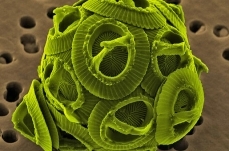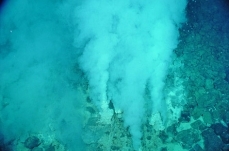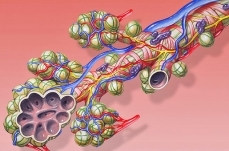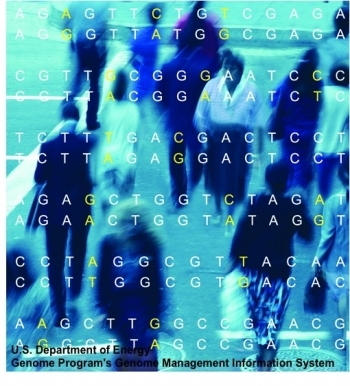Biophysics (main)
Biophysics
Biophysics is the application of physics and physical chemistry to biological systems. The field is often confined within the molecular biology realm, but it is equally valid at macroscopic scales when considering aspects of organism transport on land, in the atmosphere and in water.
Molecular biophysics addresses cellular physical chemistry such as interactions between DNA, RNA and protein biosynthesis, including regulation of these functions. Moreover, within this province are organism tissue studies including osmotic motion at the root/ soil interface; stomatal gas exchange in plants; alveoli gas exchange in animals; and electromagnetic aspects of neuron. Technology used in molecular biophysics includes electron microscopy, x-ray crystallography, nuclear magnetic resonance and polarized light spectroscopy.
At a macroscopic level, biophysics is concerned with quantification of organism morphology and fitness. Thus, measurement of animal movement (velocity and acceleration) and body mass are fundamental in assessing fitness. Seed dispersal is concerned with the ability of seeds to achieve significant airborne buoyancy and range. The entire subject of animal flight is a valid subject of biophysics; moreover, the subjects of organism fluid buoyancy and swimming fitness are central in analyzing aquatic organism fitness.
</div>-
 Featured Article
Featured Article  Coccolithophores (Biophysics)Like any other type of phytoplankton, coccolithophores are one-celled marine plants that live in large numbers throughout the upper layers of the ocean. Unlike any... More »
Coccolithophores (Biophysics)Like any other type of phytoplankton, coccolithophores are one-celled marine plants that live in large numbers throughout the upper layers of the ocean. Unlike any... More »
-
 Featured Article
Featured Article  Molecule (Biophysics)A molecule is a stable aggregation of two or more atomscreated via a covalent bond formation by overlapping of electron clouds. Molecules are generally... More »
Molecule (Biophysics)A molecule is a stable aggregation of two or more atomscreated via a covalent bond formation by overlapping of electron clouds. Molecules are generally... More »
-
 Featured Article
Featured Article  Zinc (Biophysics)Previous Element: Copper Next Element: Gallium ... More »
Zinc (Biophysics)Previous Element: Copper Next Element: Gallium ... More »
-
 Featured Article
Featured Article  Heavy metal (Biophysics)A heavy metal is any one of a number of elements that exhibit metallic properties, which includes transition metals lanthanides actinides as well as the metalloids Arsenic and... More »
Heavy metal (Biophysics)A heavy metal is any one of a number of elements that exhibit metallic properties, which includes transition metals lanthanides actinides as well as the metalloids Arsenic and... More »
-
 Featured Article
Featured Article  Extremophile (Biophysics)An extremophile is an organism adapted to unusual limits of one or more abiotic factors in the environment. Some of the extreme conditions are temperature, pH, high salinity,... More »
Extremophile (Biophysics)An extremophile is an organism adapted to unusual limits of one or more abiotic factors in the environment. Some of the extreme conditions are temperature, pH, high salinity,... More »
-
 Featured Article
Featured Article  Health effects of nickelPure nickel is a hard, silvery-white metal, which has properties that make it very desirable for combining with other metals to form mixtures called alloys. Some... More »
Health effects of nickelPure nickel is a hard, silvery-white metal, which has properties that make it very desirable for combining with other metals to form mixtures called alloys. Some... More »
-
 Featured Article
Featured Article  Respiration (Biophysics)Respiration is the gas exchange effected by living organisms for the purpose of sustaining vital metabolic processes. In the case of most animals, oxygen is taken into the... More »
Respiration (Biophysics)Respiration is the gas exchange effected by living organisms for the purpose of sustaining vital metabolic processes. In the case of most animals, oxygen is taken into the... More »
-
 Featured Article
Featured Article  Calcium (Biophysics)Calcium is the chemical element with atomic number 20; it has an atomic mass of 40.078 atomic mass units (amu). The chemical symbol for calcium is Ca. Calcium is a soft gray... More »
Calcium (Biophysics)Calcium is the chemical element with atomic number 20; it has an atomic mass of 40.078 atomic mass units (amu). The chemical symbol for calcium is Ca. Calcium is a soft gray... More »
-
 Featured Article
Featured Article  Virus (Biophysics)A virus is a microscopic organism that can replicate only inside the cells of a host organism. Most viruses are so tiny they are only observable with at least a conventional... More »
Virus (Biophysics)A virus is a microscopic organism that can replicate only inside the cells of a host organism. Most viruses are so tiny they are only observable with at least a conventional... More »
 Biological corridor (Biophysics) Last Updated on 2014-11-30 21:27:13 Biological corridor is the designation for a continuous geographic extent of habitat linking ecosystems, either spatially or functionally; such a link restores or conserves the connection between habitats that are fragmented by natural causes or human development. Such corridors are an important aspect in the preservation of species richness and biodiversity. There are different scales of biological corridors, but all share the same purpose of providing connections for species through fragmented landscapes. A biological corridor, alternatively termed habitat corridor, is used for the transportation functions of fauna and seed dispersal/propagation routes for flora and lower life forms. Specific elements of this transport for fauna include seasonal or migration movement, life cycle links, species dispersal, re-colonization of an area and movement in... More »
Biological corridor (Biophysics) Last Updated on 2014-11-30 21:27:13 Biological corridor is the designation for a continuous geographic extent of habitat linking ecosystems, either spatially or functionally; such a link restores or conserves the connection between habitats that are fragmented by natural causes or human development. Such corridors are an important aspect in the preservation of species richness and biodiversity. There are different scales of biological corridors, but all share the same purpose of providing connections for species through fragmented landscapes. A biological corridor, alternatively termed habitat corridor, is used for the transportation functions of fauna and seed dispersal/propagation routes for flora and lower life forms. Specific elements of this transport for fauna include seasonal or migration movement, life cycle links, species dispersal, re-colonization of an area and movement in... More »  Meteorology (Biophysics) Last Updated on 2014-10-26 16:32:04 Meteorology is the scientific study of the atmosphere and physical processes of interaction with the Earth's crust, oceans and outer space. Meteorological phenomena are observable weather events which are investigated by the science of meteorology. The chief parameters comprised by the science of meteorology are: temperature, barometric pressure, humidity, sunlight and the gradients and interactions of each variable, as well as their temporal variability. The majority of Earth's observed weather is located in the troposphere. Different spatial scales are studied to determine how systems on local, regional, and global levels impact meteorological phenomena. Meteorology, climatology, atmospheric physics and atmospheric chemistry are sub-disciplines of the atmospheric sciences. Meteorology and hydrology compose the interdisciplinary field of hydrometeorology. Interactions... More »
Meteorology (Biophysics) Last Updated on 2014-10-26 16:32:04 Meteorology is the scientific study of the atmosphere and physical processes of interaction with the Earth's crust, oceans and outer space. Meteorological phenomena are observable weather events which are investigated by the science of meteorology. The chief parameters comprised by the science of meteorology are: temperature, barometric pressure, humidity, sunlight and the gradients and interactions of each variable, as well as their temporal variability. The majority of Earth's observed weather is located in the troposphere. Different spatial scales are studied to determine how systems on local, regional, and global levels impact meteorological phenomena. Meteorology, climatology, atmospheric physics and atmospheric chemistry are sub-disciplines of the atmospheric sciences. Meteorology and hydrology compose the interdisciplinary field of hydrometeorology. Interactions... More »  Successional Soils: How edaphic conditions change within aggrading forests in a case study of the North Carolina Piedmont Last Updated on 2014-06-30 15:03:45 Soil composition—its abiotic physical and chemical properties—changes under an aggrading forest. Through "space for time studies" in the Piedmont of North Carolina, researchers have examined changes in soil composition and processes among three successional stages of old fields. Differences in nitrification rates, nutrient concentration, and acidity indicate that soil nutrient availability decreases during the course of forest succession. The characteristics of forest change are highly interconnected with changes in soil conditions through time. A positive relationship exists between species richness and soil nutrient availability. Organisms can change the chemical composition of the soil, which in turn influences the forest composition. For example, some species of trees and other plants decrease soil pH while others increase nitrogen availability. Much... More »
Successional Soils: How edaphic conditions change within aggrading forests in a case study of the North Carolina Piedmont Last Updated on 2014-06-30 15:03:45 Soil composition—its abiotic physical and chemical properties—changes under an aggrading forest. Through "space for time studies" in the Piedmont of North Carolina, researchers have examined changes in soil composition and processes among three successional stages of old fields. Differences in nitrification rates, nutrient concentration, and acidity indicate that soil nutrient availability decreases during the course of forest succession. The characteristics of forest change are highly interconnected with changes in soil conditions through time. A positive relationship exists between species richness and soil nutrient availability. Organisms can change the chemical composition of the soil, which in turn influences the forest composition. For example, some species of trees and other plants decrease soil pH while others increase nitrogen availability. Much... More » -PLoS.jpg) Top-down control (Biophysics) Last Updated on 2014-06-23 17:39:31 All organisms require energy and nutrients in some form to survive and grow. Thus, the existence and total biomass of ecosystems are ultimately regulated from the "bottom up", that is, by availability of resources such as sunlight, inorganic nutrients, water and other abiotic factors. Nevertheless, on more localized scales, the abundances of organisms at lower trophic levels can be strongly affected by their own predation, that is, by top-down control. Ecosystems often have been assumed to be controlled from the bottom:up, wherein nutrients and light stimulate primary production by plants, and the greater primary production in turn supports more animal production at higher trophic levels. But this is not the whole story. A simple way to envision top-down control is as follows: because the predator eats prey, the prey population is reduced, so when predators are removed,... More »
Top-down control (Biophysics) Last Updated on 2014-06-23 17:39:31 All organisms require energy and nutrients in some form to survive and grow. Thus, the existence and total biomass of ecosystems are ultimately regulated from the "bottom up", that is, by availability of resources such as sunlight, inorganic nutrients, water and other abiotic factors. Nevertheless, on more localized scales, the abundances of organisms at lower trophic levels can be strongly affected by their own predation, that is, by top-down control. Ecosystems often have been assumed to be controlled from the bottom:up, wherein nutrients and light stimulate primary production by plants, and the greater primary production in turn supports more animal production at higher trophic levels. But this is not the whole story. A simple way to envision top-down control is as follows: because the predator eats prey, the prey population is reduced, so when predators are removed,... More »  Counter current exchange Last Updated on 2014-06-19 15:47:30 Counter current exchange is the mechanism by which some property of a fluid, such as heat or a chemical substance, is transferred from one fluid across a semi-permeable membrane or thermally conductive material to another fluid flowing in the opposite direction. The general requirements for counter current exchange are (1) that two fluids flow in close proximity to each other and (2) that the fluids flow in opposite directions. The purpose of counter current exchange is to maintain a concentration gradient between the two fluids in order to maximize movement from one fluid to the other. The opposite of counter current exchange occurs in concurrent exchange when two fluids flow in the same direction. The principle of counter current exchange can be illustrated using fish gills. In the gills, oxygen diffuses from an area of high concentration, the water, into an area of lower... More »
Counter current exchange Last Updated on 2014-06-19 15:47:30 Counter current exchange is the mechanism by which some property of a fluid, such as heat or a chemical substance, is transferred from one fluid across a semi-permeable membrane or thermally conductive material to another fluid flowing in the opposite direction. The general requirements for counter current exchange are (1) that two fluids flow in close proximity to each other and (2) that the fluids flow in opposite directions. The purpose of counter current exchange is to maintain a concentration gradient between the two fluids in order to maximize movement from one fluid to the other. The opposite of counter current exchange occurs in concurrent exchange when two fluids flow in the same direction. The principle of counter current exchange can be illustrated using fish gills. In the gills, oxygen diffuses from an area of high concentration, the water, into an area of lower... More » 